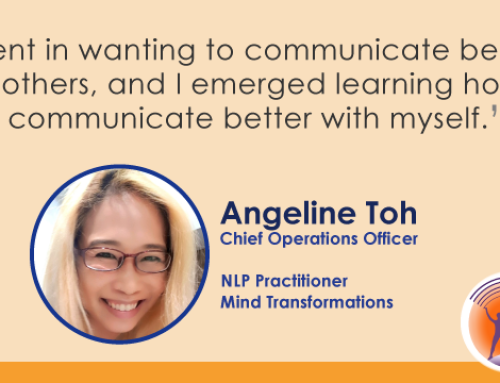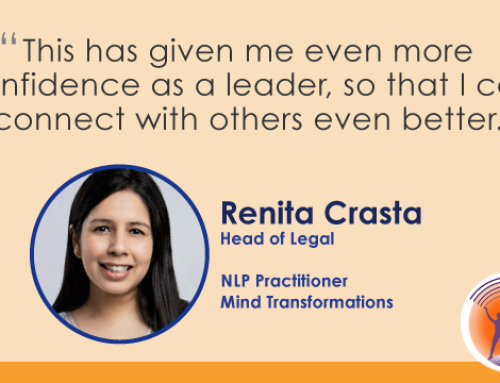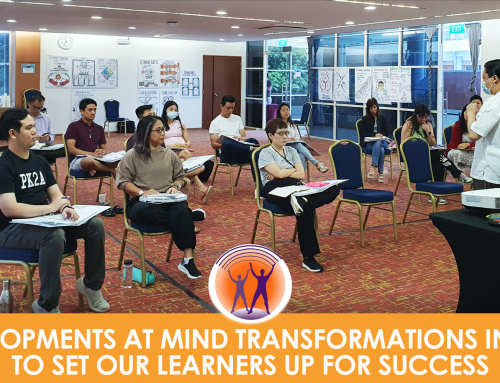by Sandra
I have made use of NLP multi-dimensional coaching techniques to varying degrees in many areas of my professional life: in coaching colleagues, in enhancing relationships, during meetings with clients, and when designing and delivering training. I design and deliver mainly financial training to people across a range of industries, roles and experience.
Coaching Staff
A particular instance in which I consciously applied several NLP multi-intelligences coaching techniques was during a feedback session for a colleague who was new to training and had just delivered a first session with me.
I found that the use of perceptual positions enhanced awareness of her performance.
By consciously putting herself in the position of a participant (position 2) and of an observer (position 3, effectively my position), as well as assessing herself from position 1, she was able to give herself more feedback. I also found that she was able to give herself all the feedback points I would have given her – the crucial difference was that it all came from her.
Following the feedback, and asking her to pick a couple of development points to focus on, I led her through an objective setting exercise, using the PCECPREWA model for setting a positive and compelling objective;
P (ositively stated outcome)
C (ontrol over outcome)
E (vidence of outcome)
C (ontext in which outcome will be achieved)
P (what is preventing the subject from achieving the outcome)
R (esources)
E (cological – what effects of the subject’s environment will achievement of the outcome have)
W(orthwhile – is the outcome worthwhile)
A (ctions). The approach gave a structure to the exercise, ending with some concrete actions for her to further her development.
Finally, and I was most cautious about this technique as I have not used anything remotely similar in the workplace before, I asked her to pace herself for the future—by imagining she was viewing a video of herself delivering a session in the future, after having fulfilled her objectives. As she pictured herself thus, I noticed a shift in her physiology: she was smiling more, her eyes looked brighter and she was sitting more upright. So this is something I shall use more often!
I received feedback from her, and through other colleagues. Whilst we only spent less than an hour together, she mentioned that she learned a great deal from the training and coaching experience. Other colleagues gave similar feedback.
Improving My Own Performance
I have used some future pacing techniques to enhance my own performance and reduce the stress in delivering training, which have worked in a subtle way.
I find that bearing some key NLP presuppositions (empowering beliefs) in mind when training really changes my perception of the relationship between myself and the participants.
For example: bearing in mind that participants are very experienced individuals and that they ‘have all they need to succeed’, changes the dynamics – I focus on drawing out what they already know and show them that they ‘can do’, rather assuming the role of ‘teacher’ and feeding them information. I have found that this has enhanced my training delivery and takes the pressure off me, making it less stressful.
Assume nothing as a trainer!
Framing (better known in my environment as ‘managing expectations’) is key in training, and whilst I did it to a certain extent before finding out about NLP, I am now more stringent with myself in framing each session of the course. Explicitly setting the tone, the learning process and the outcomes for the day/session guides participants through the learning. They know what to expect and where you are taking them, and I have found that, as a result, there is far more co-operation between trainer and participant.
The concept of ‘map of the world’ has also been very useful to me in dealing with questions or confusion. I accept that it is fine to repeat, reiterate or re-explain concepts, and focus on doing so in more than one way, thereby eliminating the fear of frustrating participants and myself!
Catering to the Individual’s Learning Modes
I ensure that my training caters for people with visual (posters, slides) auditory (music, discussion), kinaesthetic (exercises or games involving props) – and of course, gustatory (i.e. chocolates to be won!) preferred representational systems. All of us have a preferred representational system through which we use a dominant sensory system to gather information from the environment. This makes the learning experience more fun not only for participants, but for me too, and invariably the results are apparent in the feedback.
There are so many opportunities to apply NLP in training.
I am certain I have a long way to go yet! I strongly feel that my development is supported by the NLP tools I picked up on the NLP Practitioner course. NLP has also added a new dimension to the skill of training for me.
It is obvious that Barney uses lots of Multi-Intelligences NLP coaching strategies to great effect in his training of the practitioner course: this is one of the few courses I have been on after which I still remember so much!
Sandra (surname withheld), is a corporate trainer.
Like her, you too can benefit from NLP in coaching, training and your overall performance. Meet with us for a complimentary 1:1 NLP Starter Session—learn more about maximising our NLP course for your development.
[inf_infusionsoft_inline optin_id=”optin_2″]






